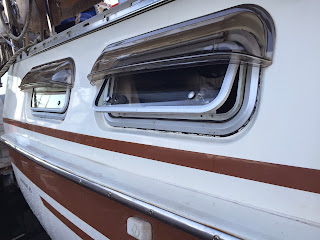Ship-to-Shore Radio: A combination radio transmitter/receiver that permits captains and crew members to obtain wrong numbers and busy signals while at sea... (Sailing Pocket Dictionary by Henry Beard & Roy McKie)The last few days while working on our house in Fairbanks we have been reminded one can never take the internets for granted...
Since moving onto the boat this spring, we have been completely reliant of our AT&T smart phones for internet connectivity. The last 4 days in Fairbanks, the cell tower nearest our house has been dysfunctional as far as cell data is concerned. When we take our phones to town, everything works fine... [There is even LTE in town- which we don't get at home even when everything is working normally...]
Yesterday afternoon [Day 3 of the service disruption] I spent an hour on the phone with an eager and helpful AT&T tech who, among other things, reset cell tower connections to my phone several times- having me reboot my phone in between. But in the end, their efforts yielded no results.
The tech then opened and escalated a trouble ticket. Here we are 24 hours later with no change.
My point is we cannot assume this stuff will work all of the time, giving us pause to reconsider reliance on a single source [if it is a critical service...] In this case, right now it hasn't worked for over 13% of the current billing period... Do you suppose they will see fit to apply that percentage discount to the data portion of our next bill?... I mean, when your power goes out...
[Update: This AT&T outage lasted 15 days, or 50% of our billing period...]
On the other hand, perhaps AT&T is doing us a favor... It is easy to become dependent upon the internet and ignore other means of communication, or life in general...
I lament at the state of our media choices: we started with smoke signals and drums, advanced to morse code, then teletype. Next came voice, then video calls... Cool. Now, as a culture, we have digressed back to teletype (text messaging…) as our communication method of choice… At least the terminals are compact and portable...
Some of you may be wondering how we posted this if we have no internet connectivity... good catch!
Using our trusty UUplus eMail service (for the bandwidth challenged...) we have squeaked through some emails on the rare intervals of Edge cell data service being available. [We have seen blazing network speeds of up to 10.4 KB/second... Hey, that's 4 times faster than our sat phone and doesn't cost $1/minute...] Our blog is set up to auto-publish emails we send to a special address... Just because we are in the dark, and can't even see our own blog, doesn't mean you should be... After all, this is how it will be when we are at sea… Practice...
For this privilege of being able to communicate using our chosen methods, we spend several hundred dollars a month [cell, sat, and UUplus plan. Thankfully other email and blogs are free...] All this just so we can send an occasional [plain text] eMail and photo? [And do our banking, purchasing, research, etc…]
We may have to re-evaluate our budget priorities in the future and consider a further digression- perhaps this time to smoke signals… or perhaps one of the more labor intensive but free HAM radio email services...
--






















